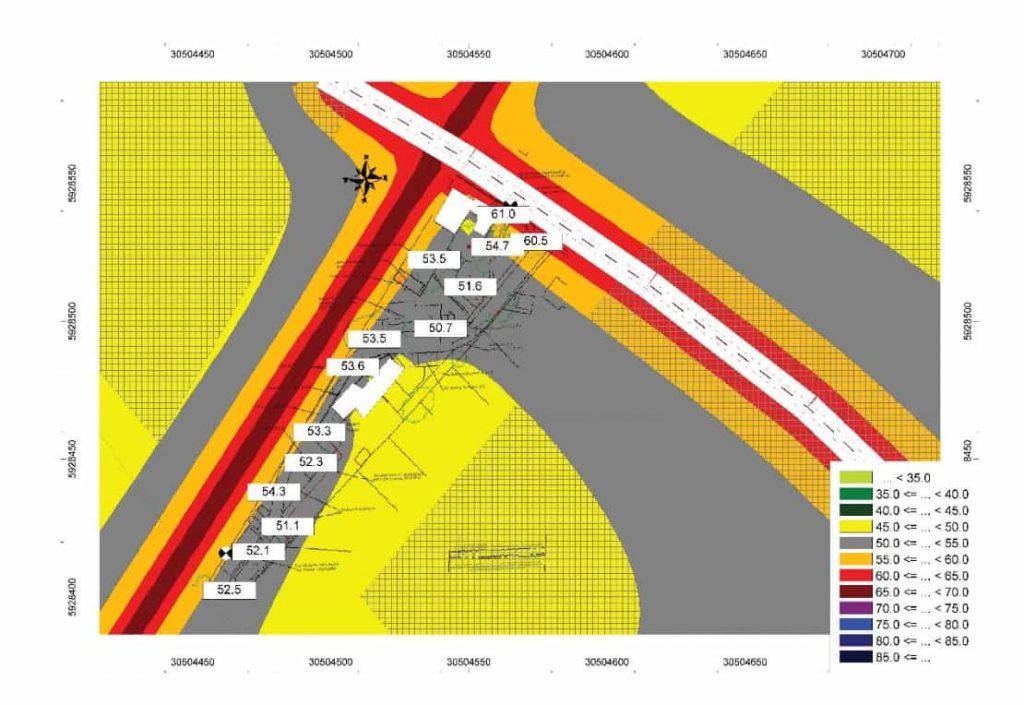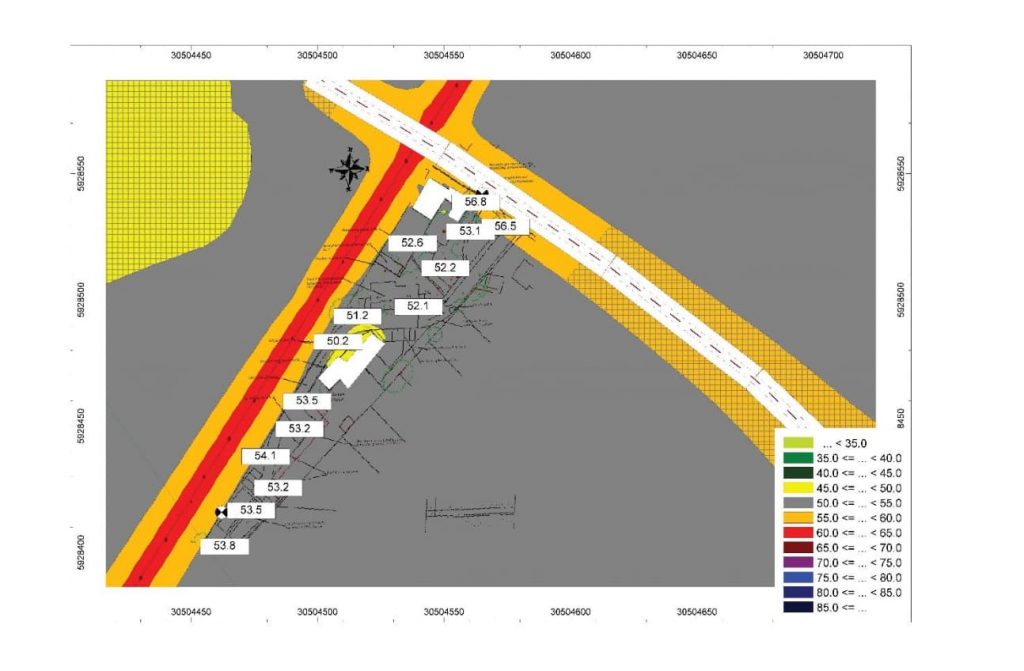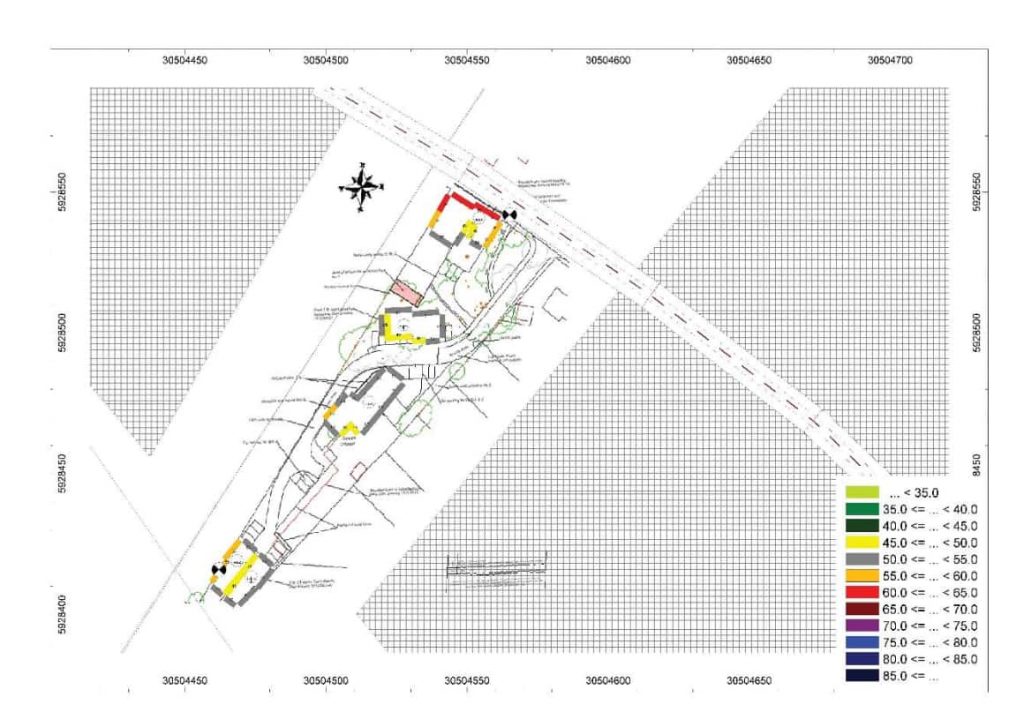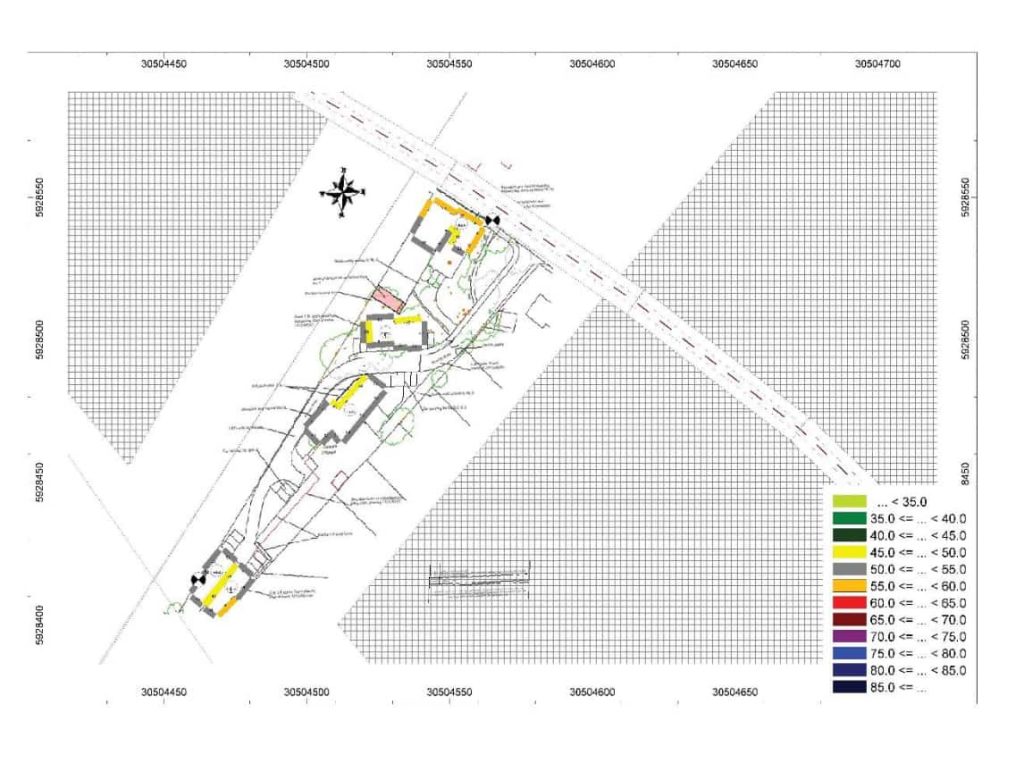A residential noise assessment is typically required as part of a planning application for new residential dwellings, to demonstrate the proposed location is acceptable from a noise perspective with adequate internal noise levels achievable within the dwellings. The residential noise assessment process involves several key steps:
Noise Survey Preparation
Acoustic consultants plan the noise impact assessment, firstly by identifying the potential noise sources impacting on the proposed development (the noise sensitive receptor).
The noise sources impacting on proposed residential schemes can include the following as examples.
- Road Traffic Noise
- Railway Noise
- Aircraft Noise
- Industrial Noise
- Commercial Noise
- Entertainment Noise
Road traffic noise can vary significantly depending on the road type and how busy it is. The speed limit of the road is a major factor, along with the number of lanes of the road, and whether it is a major route in a busy area or not.
Traffic lights, roundabouts and other traffic flow measures all impact on the dominance of the noise from road traffic. In areas in close proximity to traffic lights the noise of running engines is common, while in high-speed areas tyre noise is common, enhanced by wet weather.
Railway Noise can vary significantly depending on what trains are using the routes. Are they public trains or freight trains? Are they local trains, or high-speed intercity trains?
Aircraft noise can be significant if the proposed development is near a major airport and under a flight path.
Industrial noise can be complex with for example tonal noise sources from plant and equipment used in industrial processes.
Commercial Noises is a broad brush, but in general all businesses generate an element of noise, from mechanical plant servicing the building they are within, to deliveries of goods.
Entertainment Noise generally covers music noise and people noise. From a night club with noise breaking out to the surrounding area, with gatherings of people in the early hours of the morning at closing times, to small bars and restaurants, and external beer gardens impacting on the surrounding areas. Acoustic Standards for Planning and Noise
There are many different guidance documents which can be used in relation to noise impact assessments. It is essential for the Acoustic Consultant to use the correct standards and guidance for the particular situation.
The following examples are guidance and standards which can be used for noise impact assessment:
- National Planning Policy Framework (NPPF) 2021;
- Noise Policy Statement for England (NPSE) 2010;
- Professional Practice Guidance on Planning and Noise (ProPG) 2017;
- BS 8233: 2014 ‘Guidance on sound insulation and noise reduction for buildings’.
- BS4142: 2014 ‘Method for rating industrial noise affecting mixed residential and industrial areas’
Professional Practice Guidance on Planning and Noise (ProPG) 2017
ProPG seeks to secure good acoustic design for new residential developments. The guidance includes a framework to enable situations where noise is not an issue but to help identify the extent of risk at noisier sites. The guidance does not constitute an official government code of practice and neither replaces nor provides an authoritative interpretation of the law or government policy.
The guidance is restricted to sites that are exposed predominantly to noise from transportation sources. Where industrial or commercial noise is present on the site but is “not dominant”, its contribution may be included in the noise level used to establish the degree of risk. However, if the industrial/commercial source is dominant, an assessment in accordance with BS 4142 should be conducted.
A two-stage approach is considered whereby:
- Stage 1 – an initial noise risk assessment of the proposed development site is undertaken;
- Stage 2 – a systematic consideration of internal and external noise levels is considered ensuring good acoustic design and consideration of other relevant issues is recognised.
ProPG also references the World Health Organisation (WHO) guidance on maximum noise levels at night. Guidance from the WHO states that indoor sound pressure levels should not exceed approximately 45 dB LAFmax more than 10 – 15 times per night. ProPG indicates that individual noise events do not exceed 45 dB LAFmax more than 10 times a night.
Whilst ProPG does not define a measurement interval for the assessment of LAFmax levels, research has been undertaken which indicates that, for Maximum Event Level assessments, a sampling interval of between 1 and 3 minutes relates most closely to how awakening events are experienced by people when compared to longer sampling periods.
For brevity, within the study, the majority of people (circa 75-85%) under test returned to a sleep state by approximately 2.5 minutes after the initial awakening event.
In summary, a longer sampling period can result in the under assessment of the 10th highest maximum level, therefore, based upon research and the recommendation of the Institute of Acoustics (IOA), a sample measurement of 2 minutes has been used to inform this assessment.
Upon completion of the ProPG’s Stage 1 and 2 assessments, the findings should enable one of four possible recommendations to be presented to the decision maker, namely, to grant permission without conditions, grant with conditions, ‘avoid’ or ‘prevent’.
BS 8233 : 2014 ‘Guidance on sound insulation and noise reduction for buildings’
BS 8233 provides recommendations for the control of noise in and around buildings. The guidance provided includes appropriate internal and external noise level criteria which are applicable to residential buildings exposed to steady external noise sources. It is stated in the British Standard that it is desirable for internal ambient noise levels to not exceed the criteria set out in Table 2.1.
Table 2.1: BS 8233:2014 Table 4 – Indoor Ambient Noise Levels for Dwellings

Additional guidance in BS 8233 indicates that appropriate ventilation should be provided, if relying on closed windows to meet the guide values, and that such ventilation should not compromise the façade insulation and resulting noise levels.
BS 8233 additionally includes guidance on external amenity areas whereby it states that external noise levels should not exceed 50 dB LAeq, T with an upper guideline of 55 dB LAeq, T which would be acceptable in noisier environments.
The guidance also indicates that where developments are considered necessary or especially desirable, the internal targets may be relaxed by up to 5 dB with reasonable conditions still achieved.
Furthermore, due to the nationwide difficulty in satisfying the external criteria outlined above, the standard provides an over-arching consideration of how to treat external amenity areas.
It states that a compromise between elevated noise levels and other factors, such as convenience of living or making efficient use of land resources to ensure development needs can be met, might be warranted. It also important to note that the standard states that for balconies, roof gardens and terraces it is important that specification of noise limits is not necessarily appropriate.
Noise Monitoring
Acoustic monitoring equipment is installed at selected locations to measure the noise sources impacting on the proposed development. Typically noise measurements are taken over a 24-72hour period, which may include the weekend if deemed necessary for example if the residential development was in close proximity to nightlife. The measurement data collected provides an accurate depiction of the existing noise environment, including the variations throughout the day and night.
Analysis and Interpretation
The collected noise data is analysed to identify trends, patterns, and potential sources of concern. Acoustic Consultants assess the data against the applicable noise regulations and guidelines to determine compliance and evaluate the potential impact on residents.
Cadna Noise Modelling
Noise modelling is a common tool used by acoustic consultants to model the noise levels impacting on a proposed housing development for example. The noise model is calibrated using the measured noise levels at different locations of different sources allowing the consultant to model the development site before and after the introduction of new dwellings.
The acoustic consultant will then be able to access the noise impacting on different facades of buildings, with the ability to adjust the development layout to allow it to work better within the noise environment and introduce barrier for example such as fences close to noise sources to add a layer of noise mitigation.
Example images of noise models are shown below;
Daytime noise levels on the proposed development site, before new buildings are introduced;

Night-time noise levels on the proposed development site, before new buildings are introduced;

Daytime LAeq at the proposed building facades.

Night-time LAeq at the proposed building facades.

Recommendations and Mitigation Measures
Based on the measured façade levels of a noise assessment, acoustic consultants provide recommendations for mitigating noise pollution, and achieving indoor noise level criteria for example in BS8233:2014.
These mitigation measures may include changes to the proposed development layout, noise barriers and sound insulation measures. It is common practice for the noise impact assessment to result in a glazing and ventilation specification, to be used for the development to achieve the required internal noise levels in residential dwellings.
Reporting and Documentation
A detailed noise impact assessment report is compiled, suitable for submission to planning, summarising the findings of the assessment and outlining recommended mitigation measures to achieve the required planning criteria.
Talk to Peninsular Acoustics Today
In a world where noise pollution is an ever-present challenge, residential noise assessments offer a valuable tool for assessing the noise environment for the planning process.
By quantifying noise levels, identifying sources of pollution, and recommending mitigation measures, these assessments play a crucial role in protecting the health, well-being, and quality of life of residents.
As urbanisation continues to reshape our cities, the importance of prioritising acoustic considerations in residential development cannot be overstated.
When considering residential developments, ensuring compliance with noise regulations is paramount.
Peninsular Acoustics offers comprehensive residential noise assessments, expertly tailored to meet regulatory standards like BS 4142 and BS 8233. With over 20 years of experience, we adeptly balance building acoustics with external noise assessments, guaranteeing minimal environmental impact.
By engaging with local authorities early and coordinating closely with project stakeholders, we streamline the planning process, delivering concise and accurate noise assessments.
Trust Peninsular Acoustics to guide your development towards seamless planning approval, prioritising peace and tranquillity for future residents. Contact us today for all your noise assessment needs.